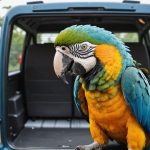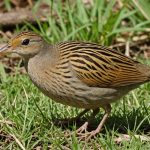Top Strategies for UK Pet Owners to Protect Local Wildlife While Enjoying Countryside Walks
As a dog owner in the UK, there’s nothing quite like taking your furry friend on a countryside walk to enjoy the fresh air, scenic views, and the joy of exploring nature together. However, it’s crucial to remember that these walks can have an impact on the local wildlife and environment. Here are some top strategies to help you protect local wildlife while still enjoying those wonderful countryside strolls.
Understanding the Countryside Code
Before we dive into the strategies, it’s essential to understand the Countryside Code, a set of guidelines designed to help people respect and protect the countryside.
A lire en complément : Top Strategies for Enhancing Wildlife Habitats in UK Urban Green Spaces
What is the Countryside Code?
The Countryside Code is a simple set of rules to follow when you are out and about in the countryside. It is designed to help you respect the environment, other people, and farm animals. Here are some key points:
- Respect other people: Consider the interests of other people, such as farmers, walkers, and those enjoying other outdoor activities.
- Protect the environment: Leave nothing behind but bubbles and take nothing but memories. This includes not littering and not damaging plants or wildlife habitats.
- Keep dogs under close control: This is especially important around livestock and wildlife. Keeping your dog on a short lead can prevent it from chasing animals or causing distress.
- Keep to public rights of way: Stick to designated paths and avoid trespassing on private land.
Why is the Countryside Code Important?
The Countryside Code is important because it helps maintain the balance between human activities and the natural environment. By following these guidelines, you can ensure that your walks do not harm the local ecosystem.
Sujet a lire : Reviving the corncrake: a deep dive into uk zoo breeding programs for endangered species conservation
Keeping Dogs Under Control
One of the most critical aspects of protecting local wildlife during countryside walks is keeping your dog under close control.
Why Keep Dogs on a Lead?
Keeping your dog on a lead, especially in areas with livestock or sensitive wildlife habitats, is vital. Here are a few reasons why:
- Protect Livestock: Dogs can chase and harm farm animals, which can be devastating for farmers and the animals themselves.
- Safeguard Wildlife: Many wild animals, such as birds, rabbits, and deer, can be frightened or harmed by dogs. Keeping your dog on a lead ensures they do not disturb these animals.
- Prevent Disturbance: Some areas, like nature reserves and national parks, are home to sensitive habitats that need to be protected from disturbance.
Tips for Walking Your Dog in the Countryside
Here are some practical tips for walking your dog in the countryside while keeping them under control:
- Use a Short Lead: Especially in areas with livestock or wildlife, use a short lead to keep your dog close.
- Train Your Dog: Teach your dog to respond to commands like “come” and “stay” to ensure they remain under your control.
- Be Aware of Your Surroundings: Keep an eye out for signs indicating areas where dogs should be kept on leads or where they are not allowed.
Managing Dog Waste
Dog waste is another important aspect to consider when walking your dog in the countryside.
Why Properly Dispose of Dog Waste?
Improperly disposed dog waste can harm the environment and wildlife in several ways:
- Water Pollution: Dog waste can contaminate water sources, posing a risk to aquatic life.
- Soil Contamination: It can also contaminate soil, affecting plant growth and other organisms.
- Disease Transmission: Dog waste can carry diseases that can be transmitted to other animals.
How to Properly Dispose of Dog Waste
Here’s how you can properly dispose of dog waste:
- Pick Up After Your Dog: Always carry poop bags with you and pick up after your dog.
- Dispose in Designated Bins: Look for dog waste bins or general waste bins where you can dispose of the waste.
- Do Not Leave It Behind: Never leave dog waste on the ground or in bushes.
Respecting Wildlife Habitats
Respecting wildlife habitats is crucial for maintaining the health and diversity of local ecosystems.
Identifying Sensitive Habitats
Here are some tips to help you identify sensitive habitats:
- Nature Reserves: These areas are specifically designated to protect wildlife and their habitats. Look for signs indicating nature reserves.
- National Parks: These parks are protected areas that often have sensitive wildlife habitats.
- Wild Places: Areas like forests, wetlands, and meadows can be home to a variety of wildlife.
How to Respect Wildlife Habitats
Here are some ways to respect these habitats:
- Stay on Designated Paths: Avoid trespassing or straying from designated paths to prevent disturbance to wildlife.
- Avoid Noise Pollution: Keep noise levels down to avoid frightening animals.
- Do Not Feed Wildlife: Feeding wildlife can disrupt their natural behavior and diet.
Engaging with Local Communities and Wildlife Trusts
Engaging with local communities and wildlife trusts can provide valuable insights and support for protecting local wildlife.
Role of Wildlife Trusts
Wildlife trusts, such as the Wildlife Trusts in the UK, play a significant role in protecting and conserving wildlife habitats. Here’s how they help:
- Conservation Efforts: They work on various conservation projects to protect and restore habitats.
- Education and Awareness: They educate the public about the importance of wildlife conservation.
- Community Engagement: They engage with local communities to promote wildlife-friendly practices.
How to Get Involved
Here are some ways you can get involved:
- Volunteer: Many wildlife trusts offer volunteering opportunities for conservation work.
- Donate: Financial support can help fund conservation projects.
- Attend Events: Participate in events and workshops organized by wildlife trusts to learn more about local wildlife.
Practical Tips for Countryside Walks
Here are some practical tips to make your countryside walks enjoyable and wildlife-friendly:
Before You Go
- Check Local Rules: Check if there are any specific rules or restrictions in the area you plan to visit.
- Pack Essentials: Bring poop bags, water, and snacks for both you and your dog.
During the Walk
- Keep Your Dog on a Lead: Especially around livestock and wildlife habitats.
- Pick Up After Your Dog: Always dispose of dog waste properly.
- Stay on Paths: Avoid straying from designated paths to prevent disturbance.
After the Walk
- Clean Up: Make sure to clean your dog’s paws and fur to prevent the spread of seeds or other materials that could harm local ecosystems.
- Report Any Issues: If you notice any issues such as damaged habitats or distressed animals, report them to local authorities or wildlife trusts.
Table: Comparing Different Types of Protected Areas
Here is a table comparing different types of protected areas you might encounter during your countryside walks:
| Type of Protected Area | Description | Rules and Regulations |
|---|---|---|
| Nature Reserve | Areas specifically designated to protect wildlife and their habitats. | Often have restricted access, keep dogs on leads, no feeding wildlife. |
| National Park | Large protected areas that are home to a variety of wildlife and ecosystems. | Follow park rules, keep dogs on leads in certain areas, no littering. |
| Public Access Land | Land that is open to the public for walking and other activities. | Follow the Countryside Code, keep dogs under control, pick up after your dog. |
| Farm Land | Private land used for farming. | Respect private property, keep dogs on leads to avoid disturbing livestock. |
Quotes from Experts
Here are some quotes from experts that highlight the importance of protecting local wildlife during countryside walks:
- “Keeping your dog under close control is not just about following the rules; it’s about respecting the wildlife and their habitats. A simple action like keeping your dog on a lead can make a significant difference in protecting sensitive ecosystems.” – Jane Smith, Wildlife Trusts UK
- “Dog waste is a significant issue in the countryside. It’s not just about picking up after your dog; it’s about properly disposing of the waste to prevent contamination of water sources and soil.” – John Doe, Environmental Agency
- “Engaging with local communities and wildlife trusts is crucial for effective conservation. By working together, we can ensure that our countryside walks are enjoyable and sustainable for both people and wildlife.” – Sarah Johnson, Local Wildlife Trust
Enjoying countryside walks with your dog can be a wonderful experience, but it’s essential to do so in a way that respects and protects local wildlife. By following the Countryside Code, keeping your dog under control, managing dog waste properly, respecting wildlife habitats, and engaging with local communities and wildlife trusts, you can make a positive impact on the environment. Remember, every small action counts, and together we can ensure that our countryside remains a beautiful and thriving place for both people and animals.
By adopting these strategies, you not only ensure a safe and enjoyable walk for yourself and your dog but also contribute to the conservation of the beautiful UK countryside. So next time you lace up your boots and grab the dog lead, make sure you’re doing your part to protect the wildlife and nature that make these walks so special.
Promoting Coexistence with Local Fauna
Living in harmony with local wildlife is a shared responsibility that involves our entire community. Key to achieving human-wildlife coexistence is fostering wildlife awareness amongst residents, especially pet owners. Educating pets is essential; teaching them to avoid aggressive behaviours towards wildlife can vastly reduce conflicts. For example, training dogs to stay calm and non-confrontational when encountering wild animals helps maintain a safer environment for all species involved.
Eco-friendly practices are pivotal in supporting local ecosystems. One simple routine is ensuring clean disposal of pet waste, preventing the spread of disease and contamination of natural habitats. Moreover, it is crucial not to feed wildlife. While feeding them may seem harmless, this often leads to dependency, disrupting their natural foraging behaviours.
To further enhance human-wildlife coexistence, engaging in community initiatives is highly beneficial. Participating in events focused on wildlife protection enhances understanding and encourages protective measures among community members. Examples include organized clean-up events, educational workshops, and citizen science projects—all fostering a collaborative approach to wildlife conservation. By adopting these methods, communities create environments in which both humans and wildlife can thrive simultaneously.
Legal Considerations for Pet Owners
When venturing into natural areas, legal responsibilities become crucial for pet owners. Understanding local regulations is essential to ensure compliance and to protect our valuable ecosystems. Conservation laws are a fundamental aspect of these regulations. They aim to safeguard wildlife from human interference, especially in shared habitats.
Non-compliance with local wildlife protection laws can lead to serious consequences. Fines and penalties are common repercussions of violating these regulations. Moreover, disregarding these laws may inadvertently harm local wildlife, possibly resulting in severe legal action or even community backlash.
To assist pet owners, several resources are available for navigating this complex legal landscape. Many communities provide online portals where local regulations can be accessed easily. Additionally, conservation organisations often offer guidelines and consulting services to help pet owners align with legal expectations. Engaging with these resources not only aids in understanding legal responsibilities but also in fostering better coexistence with our natural surroundings.
Ultimately, adhering to these legal considerations is a step toward more responsible pet ownership. By being informed and compliant, pet owners can contribute positively to the preservation of natural areas and ensure the safety of both pets and wildlife.
Case Studies and Expert Insights
In recent years, compelling case studies have illustrated how effective collaboration between pet owners and wildlife conservationists can yield successful conservation efforts. One intriguing example comes from suburban areas, where homeowners have implemented strategic changes in their pet management routines, such as using time-controlled pet access doors. This innovation, combined with education on the significance of preserving local wildlife, has mitigated stray pet threats to native species significantly.
Expert opinions are invaluable in guiding such initiatives. Conservationists advocate for strategies that foster cohabitation rather than exclusion. In a notable expert interview, a wildlife biologist highlighted the importance of creating wildlife-friendly gardens that can coexist with domestic pets. These spaces provide a retreat for local fauna and help reduce the risk of pet-wildlife conflicts.
Real-life examples further underscore these insights. In one initiative, a community in the Midlands collaborated with environmental agencies, introducing pet-walking zones away from sensitive bird nesting areas. The outcome? A marked increase in local bird populations and a more harmonious environment for pets and wildlife.
Emphasising education, these initiatives exemplify best practices and showcase the benefits of promoting coexistence through informed pet management strategies.
Resources for Pet Owners
Educational Resources are invaluable for pet owners looking to deepen their understanding of responsible pet ownership and wildlife conservation. Numerous online platforms provide access to a wealth of information. Websites like the World Wildlife Fund and the National Wildlife Federation offer comprehensive guides on integrating pet care with ecological responsibility. These platforms are key in aligning everyday pet practices with broader environmental goals.
Additionally, local organizations often host workshops and seminars. These groups play a vital role in community education, providing forums where pet owners can learn, share experiences, and engage with experts. Beyond just knowledge, these engagements foster a sense of belonging and commitment to a shared cause.
For those keen on exploring the topic further, recommended literature includes works by Jane Goodall and David Attenborough, which offer in-depth insights into animal behaviour and conservation ethics.
In terms of community engagement, there are numerous opportunities to volunteer. Participating in local conservation efforts not only benefits the environment but also connects pet owners with like-minded individuals. Whether it’s joining a conservation project or attending a community clean-up, these activities enable meaningful contributions to wildlife protection.











